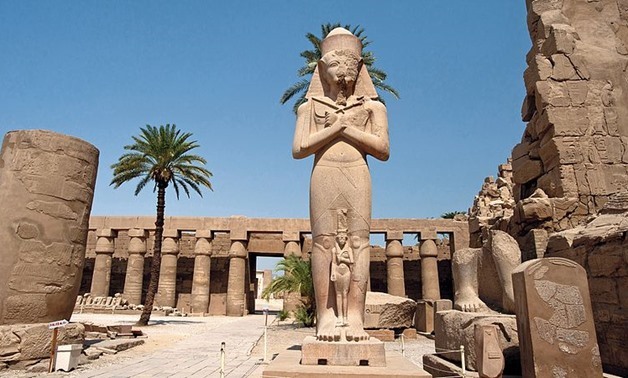
Temple of Luxor in Egypt July 18, 2016 – Photo courtesy of Wikimedia
CAIRO – 16 February 2018: A British media delegation headed by the British director Martin Gorst and the British photographer Sacha Thorpe finished shooting their documentary about Aswan.
The British delegation finished shooting all the scenes in Aswan. This documentary is part of a series of documentaries entitled “Discovering Ancient Egypt” which is produced by both the British Television and National Geographic. The series aims to shed the light on Egyptian Ministry of Antiquities as well as foreign and Egyptian missions’ efforts to discover and preserve the Egyptian monuments.
The British delegation photographed the Nile, the city of Aswan, the granite quarries and the missing mausoleum, in addition to portraying a model of how to make pharanoic obelisks of granite in ancient Egypt and how to move them and raise them. Gorst shot as well Karnak Temple in Luxor.
The documentary is scheduled to be screened in July 2018 in the United States, France and some European countries, where it is expected to promote the Egyptian tourism.
Luxor and Aswan are two cities in Upper Egypt known to be home of intact ancient Egyptian temples that date back almost 4,000 years ago. Luxor alone has one third of the world’s ancient monuments, and many Egyptians like to call Aswan the “Egyptian Paradise.”
The Luxor and Karnak temples in Luxor are a must-see attractions, and Aswan also has many temples, such as Kom Ombo, Philae and Abu Simbel, which is almost 300 kilometers away from the city, but there are regular trips to it from Aswan.
The temple complex of Abu Simbel is one of the most popular monumental buildings in Aswan, which is located at the second cataract of the Nile River.
The temple, carved out of a sandstone cliff on the west bank of the Nile, was discovered twice. It was initially discovered in 1813 by Swiss researcher Johann Ludwig Burckhardt, and then rediscovered in 1817 by Egyptologist Govani Battista.
At the entrance of the Abu Simbel temple, there are two seated statues of the Pharaoh, showing the ruler with a short kilt, a beautiful headdress which is a double crown with a cobra and a false beard. Next to the statues’ legs, are smaller statues of the Pharaoh’s relatives. At the top of the temple is a row of 22 squatting baboon statues. The baboon’s cry was believed to welcome the rising sun.
Inside the temple, there are images and hieroglyphics, describing Ramses II’s victory at the battle of Qadesh, in addition to empty store rooms.
According to many scholars, this great temple was created to celebrate the victory of Ramses II over the Hittites at the Battle of Qadesh in 1274 BC. This means that the temple was situated on the border of the conquered lands of Nubia after many military campaigns were carried out by the Pharaoh against Nubia.
Abu Simbel is made up of two temples. The smaller one was built for Queen Nefertari and has two statues of her and four pharaohs; each about 33 feet (10 meters) in height.
Ramses II built this temple to impress Egypt's southern neighbors, and also to reinforce the status of the Egyptian religion in the area. Abu Simbel was one of six rock temples erected in Nubia during the ruling period of Ramses II and its construction took 20 years from 1264 BC to 1244 BC .
UNESCO considers the Abu Simbel Temple one of the historical and monumental places that has to be protected against floods.
It is worth mentioning that the Ministry of Antiquities announced two massive archaeological discoveries in Aswan, on Thursday, January 11.
The first discovery was made by the Egyptian-American archaeological mission of The Oriental Institute of the University of Chicago during its excavation works at Tell Edfou site. The mission unearthed an administrative complex that dates back to the fifth dynasty of ancient Egypt.
The unearthed complex is considered the oldest archaeological discovery in Tell Edfou site. This area probably still hides great secrets underground.
This discovery is special because it sheds light on the history of the fifth dynasty, and how ancient Egyptians used internal architectural structures to store goods, raw material, and gemstones.
The mission found more than 200 artifacts which belonged to King Djedkare Isesi, in addition to many tools used in trade campaigns to Africa.
Regarding the second discovery the Egyptian mission uncovered, at the temple of Kom Ombo in Aswan, a statue of a man and his wife while doing some religious rituals, and a statue made of sandstone of a seated man, in addition to two statues of god Horus in the shape of a raven.

Comments
Leave a Comment